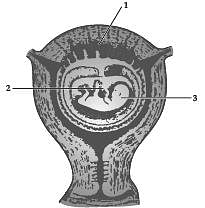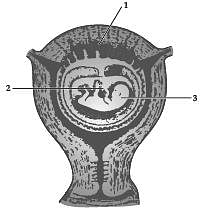Test: Human Reproduction- Case Based Type Questions - NEET MCQ
15 Questions MCQ Test Biology Class 12 - Test: Human Reproduction- Case Based Type Questions
Study the given diagram and answer any of the four questions given below :

Identify the parts labelled 1, 2 and 3 in the diagram given.

Read the following text and answer the following questions on the basis of the same: During sexual reproduction, the male inserts the sperm into the female reproductive tract, and sperm receive by the ovary and after that sperm fuse with the egg (ovum) in the ampullary region, this process is called fertilization, haploid nucleus of sperm fuse with that of ovum to form Diploid zygote.
The phenomenon of sperm activation in mammals is known as.
| 1 Crore+ students have signed up on EduRev. Have you? Download the App |
Directions : In the following questions a statement of assertion (A) is followed by a statement of reason (R). Mark the correct choice as :
Assertion (A) : Blastocyst undergoes gastrulation to form three germinal layers.
Reason (R) : This involves cell movements (morphogenetic movement) that help to attain new shape and morphology of embryo.
Study the given diagram and answer any of the four questions given below :

During embryonic development which of the following is formed first ?
Read the following text and answer the following questions on the basis of the same: During sexual reproduction, the male inserts the sperm into the female reproductive tract, and sperm receive by the ovary and after that sperm fuse with the egg (ovum) in the ampullary region, this process is called fertilization, haploid nucleus of sperm fuse with that of ovum to form Diploid zygote.
Fertilization take place in :
Read the following text and answer the following questions on the basis of the same: Read the passage and answer any four questions : Implantation is the embedding of the blastocyst into the endometrium of the uterus. Blastocyst is a ball of cells with a large, fluid-filled cavity called the blastocoel. The blastomeres in the blastocyst are arranged into an outer layer called trophoblast and inner cell mass. With the formation of blastocoel, morula is converted to blastula which is called blastocyst in mammals.
State of embryo development, in which implantation occurs in human female is :
Study the given diagram and answer any of the four questions given below :

The signals for parturition originate from :
Read the following text and answer the following questions on the basis of the same: During sexual reproduction, the male inserts the sperm into the female reproductive tract, and sperm receive by the ovary and after that sperm fuse with the egg (ovum) in the ampullary region, this process is called fertilization, haploid nucleus of sperm fuse with that of ovum to form Diploid zygote.
Egg development without fertilization is known as
Read the following text and answer the following questions on the basis of the same: Read the passage and answer any four questions : Implantation is the embedding of the blastocyst into the endometrium of the uterus. Blastocyst is a ball of cells with a large, fluid-filled cavity called the blastocoel. The blastomeres in the blastocyst are arranged into an outer layer called trophoblast and inner cell mass. With the formation of blastocoel, morula is converted to blastula which is called blastocyst in mammals.
Which organ is formed during gastrulation ?
Study the given diagram and answer any of the four questions given below :

Hormones secreted by the placenta to maintain pregnancy are :
Read the following text and answer the following questions on the basis of the same: During sexual reproduction, the male inserts the sperm into the female reproductive tract, and sperm receive by the ovary and after that sperm fuse with the egg (ovum) in the ampullary region, this process is called fertilization, haploid nucleus of sperm fuse with that of ovum to form Diploid zygote.
Site of fusion of sperm with an ovum.
Read the following text and answer the following questions on the basis of the same: Read the passage and answer any four questions : Implantation is the embedding of the blastocyst into the endometrium of the uterus. Blastocyst is a ball of cells with a large, fluid-filled cavity called the blastocoel. The blastomeres in the blastocyst are arranged into an outer layer called trophoblast and inner cell mass. With the formation of blastocoel, morula is converted to blastula which is called blastocyst in mammals.
The process that transforms the embryo into a three-layered stage is called............. .
Study the given diagram and answer any of the four questions given below :

Gestation period in human is :
Directions : In the following questions a statement of assertion (A) is followed by a statement of reason (R). Mark the correct choice as :
Assertion (A) : All copulations do not lead to fertilisation and pregnancy.
Reason (R) : Fertilisation can occur only if the ovum and sperms are transported simultaneously to the ampullary-isthmic junction.
Read the following text and answer the following questions on the basis of the same: Read the passage and answer any four questions : Implantation is the embedding of the blastocyst into the endometrium of the uterus. Blastocyst is a ball of cells with a large, fluid-filled cavity called the blastocoel. The blastomeres in the blastocyst are arranged into an outer layer called trophoblast and inner cell mass. With the formation of blastocoel, morula is converted to blastula which is called blastocyst in mammals.
The ectoderm cells will form the.......................... .
|
87 videos|294 docs|185 tests
|

















